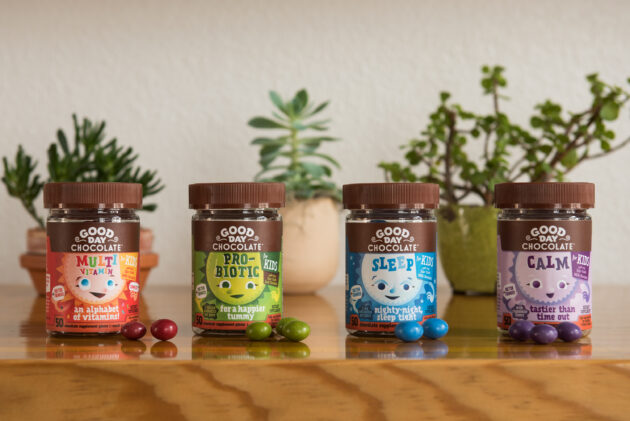
Opportunity in new sweets and indulgences
By Mark Juhasz
Food Trends confectionery Eat Gold Organics Editor pick Good Day Chocolate Mars-WrigleyWe’re seeing a trend toward low, no-added sugar confectioneries
 Manufacturers are reformulating products and experimenting with new ingredients to offer consumers healthy and tasty confectionery. Photo © Barry Callebaut
Manufacturers are reformulating products and experimenting with new ingredients to offer consumers healthy and tasty confectionery. Photo © Barry Callebaut The past few years have had a major impact on how people think about and purchase food. The COVID-19 pandemic significantly raised awareness about the importance of strong immune systems, and one’s diet in relation to that. In 2022, inflation across the global economy was particularly acute on food prices, and what has been termed the ‘cost-of-living’ crisis made consumers even more careful about their grocery purchases. Add to this a wave of policies in jurisdictions around the world that are regulating unhealthy quantities of high fat, sodium, and sugar content in products. Regulations are seeking to address epidemic cases of obesity, diabetes and a range of dietary-related alignments and conditions. For example, titanium dioxide, used to whiten or brighten foods, is prohibited in the E.U. This has created a demand for functional and efficient alternatives. A recent study from the journal, Nature Medicine, suggests the artificial sweetener erythritol may have a link to increased cardiovascular risk, even though the results remain inconclusive and context specific.
The World Health Organization has published manuals on taxation policies on confectionery for countries to promote healthier diets. Leading confectioners like Mars-Wrigley are responding in stride with major product reformulation initiatives. The range of reduced, low and no added-sugar products available has grown significantly in recent years. The thing is, consumers want healthy products that are also tasty. Traditional cane sugar has certain texture, taste, and mouthfeel functionalities that no one alternative can easily replace.

Good Day Chocolate products are designed to help with sleep and energy levels. Photo © Good Day Chocolate
New product developments
In addition to the drive toward healthy indulgence in the confectionery sector, conscious consumer choices favouring environmental-friendly and ethical products is finding its way into the category. Front-of-pack ethics is translating into tangible partnerships between confectioners and organizations working to restore and enhance ecosystems in the regions where food ingredient commodities are produced, for example, with biodiversity protection related to cacao, sugar, coffee, or vanilla production. Provenance also serves a role for some consumers, who are seeking ingredients such as Sicilian lemons, Australian orange, Sri Lankan cinnamon, or Madagascar vanilla.
The innovation happening in confectionery is also about strategically thinking which ingredients need to be replaced to still provide a satisfying and tasty experience, while meeting health benefit demands at a reasonable price point, not an easy task. As noted, sugar replacement is a highly contested area. While some alternative sweeteners like allulose, xylitol and aspartame have lower calories and glycemic indicators, they have had mixed reception in terms of consumer taste and texture response. Natural sweeteners from vegetables, tubers and plants are being utilized from monk fruit, honey, stevia, coconut, date, agave, chicory root, carrots, and berries, for example. Fruit-sourced frutafit inulin, and frutalose oligofructose are designed to reduce sugar content, increase fibre and, potentially, serve as a gut prebiotic.
Additional ingredient replacements in functional confections include replacing saturated fats with healthier alternatives. Some of this is in the form of plant oils, whether sourced from coconuts or avocados, for example, as a substitute for butter, or almond or chia seeds to add a creamy texture as a source of unsaturated fat to product formulations. Confectioners are using whole and ancient grains to add fibre (to enhance satiety or support weight management) and essential nutrients to products that are replacing refined and highly processed flours and starches. Albeit these shifts toward new ingredients are not without supply chain and price challenges and fluctuations. Production costs and consistency of availability require continual vigilance of consumer and market reception to new product formulations.
Innovative products
The multi-faceted opportunity for functional and better-for-you confectionery would suggest a sweet spot between indulgent pleasure and health, without compromising either. The sector has witnessed significant growth in confectionery launches with health claims, such as enriched vitamins, minerals, or natural plant extracts to boost an aspect of well-being. Functionality in confections can range from fibre and vitamins to different ingredients and no-animal products.
In terms of specific examples, chocolate and candy confectionery is a well-established category. Good Day Chocolate is a fair-trade dark bar developed to help with sleep and energy. Eat Gold Organics have a functional chocolate bar to support women’s menopause and libido. Sourse chocolate bites are infused with vitamins to improve mood, skin tone, and sleep. Jojo chocolate have hemp protein and fibre. Unreal makes low-sugar, dark chocolate alternatives. Chocolate brands have also promoted carbon-neutral, dairy-free, and plant-based versions of this classic indulgent snack. In the category of gummies, adaptogens such as ashwagandha are being used by Grummies. WonderDay gummies by Plant People have infused functional mushrooms into their products for improved energy, immunity, and stress-relief. 8Greens candies deliver the equivalent amount of vitamins as cups of broccoli and spinach, and Natrol Sleep+ gummies focus their product on immune-boosting and calming formulations for adults and children. According to a recent report, by mid-decade, global gummie vitamins could reach $9.3 billion in sales.
Amidst a health-centric set of signals in the confectionery sector, finding the right balance between indulgence and self-care seems more important then ever. Add to this price inflation, challenging supply chains, and the difficulty of deciphering between what consumers say and actually do at the check-out counter. Classic sweets like a candy bar or piece of rich chocolate can satisfy emotional balance. Sugar and chocolate are well-established, mature markets with dynamic innovation within them. The current developments within the category, whether dairy-free, plant-based, or low-sugar are variations that seek to reduce guilt, or aid in supporting market health signals, but confectionery is as much about enjoyment, pleasure, and satisfaction as it is about healthier lifestyles. It will depend on the product, and the consumer across the healthy, functional, better-for-you, and indulgence spectrum, whether considering caloric intake, nutritional content, ingredients, price, or ethics as a decision-making point. What is certain is that the confectionery category has a great opportunity to put out great tasting, delicious and satisfying new products in the market that innovate with new ways of redefining where health and pleasure meet.
Mark Juhasz is CEO and founder of Harvest Insights. He has more than 20 years of experience in the agri-food industry. He can be reached at www.harvestinsights.com.
This article was originally published in the April/May 2023 issue of Food in Canada.
Print this page